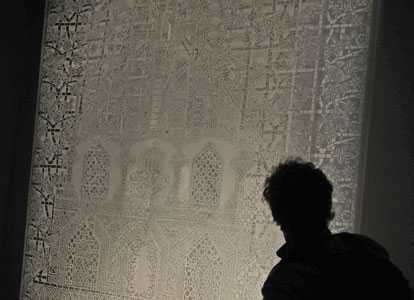By Roger Tagholm
The challenges of translating Turkish into English and what you might call Turkey’s dilemma — whether to choose the mosque or the mall, positioned as it is between East and West – were among themes addressed at the first ever conference devoted to Turkish literature, held at Oxford University last Friday. It was the first cultural activity organised by the Turkish government’s National Organising Committee ahead of the country’s position as Market Focus at next month’s London Book Fair.
Academics and scholars gathered at Ertegun House, surely the most appropriate of venues. It is named after the legendary record producer and founder of Atlantic Records Ahmet Ertegun, who was born in Turkey and whose widow, Mica, bequeathed money to the university to fund a graduate scholarship programme in the humanities. It was her thank you gesture to England after Led Zeppelin, whom her husband signed to Atlantic when they were virtually unknown, played a benefit gig in London following Ahmet’s death in 2006. A whole lotta love indeed.
The Pull Between East and West
Kicking off proceedings was the great bear-like figure of Professor Murat Belge of Istanbul’s Bilgi University, left-wing scourge of the Turkish establishment and someone who has risked prison to speak out about the plight of Turkish writers over the years. He gave a fascinating history of Turkish fiction, observing that Turkish writers had a “love hate relationship with the West. We want to be like the West — we have this envy of the west and its civilization — and yet we also dislike the west because this word ‘civilization’ can have imperialist overtones, which we don’t like.”
He said this feeling was even expressed in the country’s national anthem which includes the line “civilization: that monster with one remaining tooth.”
The early Turkish novelists of the ’20s were “nation builders, for whom the mission weighed heavier than the aesthetic,” he said. In 1971, “after one of our numerous military takeovers” (this, a nice bit of tobacco-dry humor), many women writers came to the fore, “getting into the texture of daily life and contributing greatly to the development of the Turkish novel.”
He hailed Seventies writer Oguz Atay as the “James Joyce of Turkish literature” — but he’s not translated into English — and said that today many trajectories for the Turkish novel existed. “Writers with a mission continue, but they’re mainly Islamists and the aesthetic is very weak. The post-modern novel is in vogue, with much allegorising of Turkish history. They’re great fun to read, but sometimes you forget what they are about.”
Fellow academic Dr Duygu Tekgul of Yeditepe University, Istanbul, spoke on the Modern Turkish Novel in English Translation, including digressions on Even –Zohar’s polysystem theory (“culture is a system and literature a system within that”) and Arjun Appaurai’s field theory (“the imagination has become an organized field of social practices”).
But before it became too abstract she put up slides of various jackets, including one for Perihan Magden’s 2 Girls(Serpent’s Tail) that showed two images, one of two young women by a swimming pool, the other the minarets of a mosque. She raised the issue of western publishers opting for cultural stereotypes when creating cover art. “The cover of this novel features a mosque, even if there isn’t a mosque featured in the story. But publishers think ‘it’s set in Turkey, quick, get the photo library, we need a picture of the Blue Mosque.’”
Agent Nermin Mollaoglu of the Kalem Agency in Istanbul grinned, but said she accepted the clichés on so many covers. Many authors would accept this too, if that were what it takes to get published. Only Orhan Pamuk, it seems, has the clout to have his say on his jackets, sometimes designing them himself.
Translating Turkish is Tricky, But More Are Up to the Challenge
Pamuk’s translator, the US-born journalist and novelist Maureen Freely, said that translating Turkish to English was particularly difficult. “It’s the voice, the music, the way Turkish writers play with time and structure, the aesthetic qualities of Turkish. The translator needs to find a way to capture this. It’s not just the sense, but capturing the magic that is there. The Turkish mind has a greater understanding of time and tense. Anglo-Saxon minds are more closed. We always want to know who what where when, but you can go through a whole book in Turkish not knowing that.”
But of course great things are happening in the field of translation, most notably the Turkish government’s TEDA “subvention” program, which was established in 2005 and provides grants for the translation of Turkish literature outside the country. “We have had 1,400 applications so far and have published 900 books,” said Professor Onur Bilge Kula, General Director of Libraries and Publications, Ministry of Culture and Tourism, and a driving force behind the Market Focus program. “Turkish literature is now available in 57 countries and in 53 languages. In the United States, we have supported the translation of 93 books in English. Turkish literature is now opening to the world and we are very proud of this initiative.”
With the huge success of novels like The Kite Runner, Western publishers are aware that the next big property might come from this part of the world. Freely, who runs the Literary Translation Centre at Frankfurt, had some good advice for Turkish publishers. She urged them not to worry overmuch about English or US sales, but use sales into European territories as a route in. “Editors in the UK love to visit the French, German, Spanish, Italian stands at Frankfurt. They’ll always ask ‘what’s going on? What’s good? What should I know about?’ That can be a way of reaching these publishers.”
For Turkish publishers, the next big opportunity to meet with US and UK publishers is just a few weeks away.
